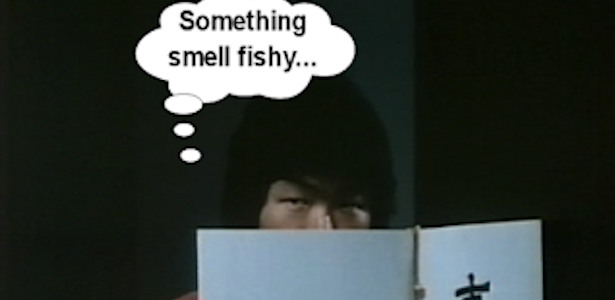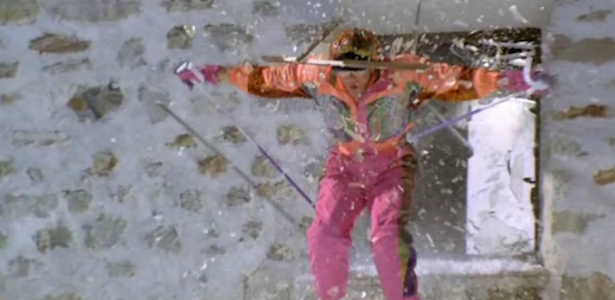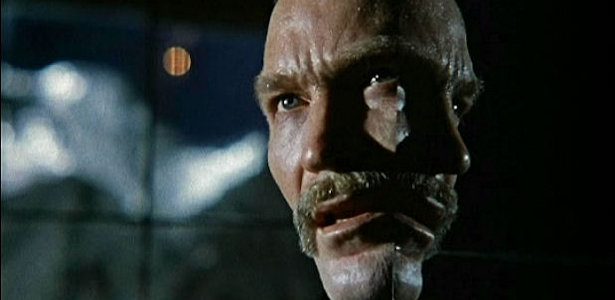The personal pendulum of Santa Claus has always amused me. After all, he is one of the most beloved people in the world (and white too, according to Fox News) according to children. How can you not love a dude who breaks into your home and leaves you awesome things? At the same time, ol’ St. Nick has produced more tears than Michael Bay’s filmography. Yes, the most adored man in the world turns most kids into blubbering messes when they see him in person (like if Tom were to meet Brian Trenchard-Smith). Truth is the dude is scary and the stuff of nightmares. Naturally, cinema has exploited this fear.
It seems only appropriate that a killer Santa would first appear in the subversive cinema of the 1970s. The Amicus anthology TALES FROM THE CRYPT (1972) made history by having a wacko in a Santa suit terrorizing an equally evil housewife (to show how far ahead of the times EC Comics producer William Gaines was, the story was originally featured in “The Vault of Horror” in 1954). It seems only appropriate that the Killer Santa theme exploded in the “go big or go home” cinema of the 1980s. Audiences were treated to a myriad of killer Kris Kringles starting with CHRISTMAS EVIL (1980) and continuing with DON’T OPEN TILL CHRISTMAS (1984) and the SILENT NIGHT, DEADLY NIGHT (1984) series. Hell, even the TALES FROM THE CRYPT cable revival in 1989 remade the classic “And All Through the House” story. Now in most cases it was just a loony in a Santa suit, but the deal was done. The dude scared people and was perfect horror movie material. After all, with a quick letter switch Santa becomes Satan.
Now, close your eyes for a minute so I can tell you a story…oh, wait, open them back up as you need to read this. Imagine a film set in 1990s New York that had a killer Santa Claus running around the city on dark nights chopping people up with an axe. Sounds amazing, right? Gives you that kind of tingly feeling you had when you heard Jason Voorhees was going to be set loose in the Big Apple, right? Well, now imagine how disappointed you felt when you saw FRIDAY THE 13th PART VIII: JASON TAKES MANHATTAN (1989). Now take that dissatisfaction, multiply it times 100 and transfer it to video. Hurts, doesn’t it? That is the crushing sense of disappointment you’ll get watching the shot-on-video SATAN CLAUS (1996).
The movie opens with a woman clad all in black performing some kind of satanic ceremony over an 8X10 of some random dude. The next scene has a lady walking home at night and she is confronted by a guy dressed as Santa Claus. Apparently she was on the naughty list as he quickly decapitates her with an axe and puts her head in his sack. Cut to a downtown police station where Captain George Ardison (Barie Snider) gets the word that it was his wife that was the victim. Oh damn, Ardison was the dude in the photo in that opening ritual. Somebody must not like him. Our killer Santa proves his lack of Yuletide cheer by taunting the police captain with phone calls and placing the lady’s severed head on top of his Christmas tree.
Meanwhile, we meet out loveable lead Steve Sanders (Robert Hector), a struggling actor who lives with a psychic black lady named Maman (Lauretta Ali). In the film’s one true scene, Steve questions his desired occupation by saying, “Truth is I’m not an actor. Maybe I should find a real job?” I couldn’t agree more, pal. Anyway, he is helping out his buddy Ken (Roy Ashton) by hanging out in the park dressed as Santa (sans beard) to collect donations for St. Mary’s orphanage. While ringing their bells, Steve and Ken are visited by Sandra Logan (Jodie Rafty), the woman who did his actor headshots, and her model boyfriend Jeff. While walking in the park and trying to get romantic, Sandra and Jeff are attacked by the killer Santa with Jeff getting an axe to his beautiful face for his trouble. With Steve as a witness, he heads to the police station to be questioned by Ardison and runs into his old flame Lisa (Daisy Vel), who is also working this case.
Anyway, the victims keep falling and the calls keep coming. Santa is dubbed “Satan Claus” by the NY media because, well, he’s evil and they love the attention-grabbing headlines. As if a killer Santa stealing body parts weren’t bad enough, the city that never sleeps now has redneck posses (well, three guys) running around pulling guns on anyone dressed in red with white trim. Wait…is it even legally possible for rednecks to be in the Big Apple? Anyway, Steve literally disarms a situation by  using his acting skills (“You’re no different than the man you are hunting.” Oh, burrrrrrrrrrrrrrrn!). Maman, meanwhile, is having bad visions about this Satan Claus. She gives Steve a pendant to protect him (it is never seen again) and later has flashes of the killer at home. This results in a great scene where Steve is saying, “What can you see?” and she vaguely describes the visions flashing in her head before screaming “31 Washington Street!” Damn, Maman good. Steve arrives at that address to find the killer Santa under his body part decorated tree and it is…Captain Ardison! But wait, Ardison had actual phone conversations with the killer Santa and was working when his wife was brutally killed. That is when a second killer Santa shows up and it is…photographer Sandra Logan! SUH-WERVE! Seems Sandra was pissed that her boyfriend Jeff was cheating on her so she decided the only recourse was to begin a series of seemingly random murders so she could off him. She then possessed the police chief via Satanism to have him commit the other murder. Ah, woman logic. Much more effective than saying, “We need to break up. I want my key back.” Such effective planning is never fully appreciated though as the cops arrive and shoot her dead. The end...thank goodness!
using his acting skills (“You’re no different than the man you are hunting.” Oh, burrrrrrrrrrrrrrrn!). Maman, meanwhile, is having bad visions about this Satan Claus. She gives Steve a pendant to protect him (it is never seen again) and later has flashes of the killer at home. This results in a great scene where Steve is saying, “What can you see?” and she vaguely describes the visions flashing in her head before screaming “31 Washington Street!” Damn, Maman good. Steve arrives at that address to find the killer Santa under his body part decorated tree and it is…Captain Ardison! But wait, Ardison had actual phone conversations with the killer Santa and was working when his wife was brutally killed. That is when a second killer Santa shows up and it is…photographer Sandra Logan! SUH-WERVE! Seems Sandra was pissed that her boyfriend Jeff was cheating on her so she decided the only recourse was to begin a series of seemingly random murders so she could off him. She then possessed the police chief via Satanism to have him commit the other murder. Ah, woman logic. Much more effective than saying, “We need to break up. I want my key back.” Such effective planning is never fully appreciated though as the cops arrive and shoot her dead. The end...thank goodness!
Sorry if I ruined the twists and turns of SATAN CLAUS for you there. Who am I kidding? The only person dumb enough to watch this would be me. This magnum non-opus is the handiwork of one Massimiliano Cerchi. Had the internet not been able to prove his existence as a real person, I would have assumed this was the handiwork of one Wally Koz, the auteur behind the shot-on-video 555 (1988). After all, Cerchi has the same aesthetic and plot style as Koz, relying on hard to make out night shots as much as scenes set in a detective’s office. The film is so dark in spots that you can barely make out what is going on. I totally wanted to see an evil Santa Claus loose in NYC movie. But I literally couldn’t see it. Even worse, Cerchi shoots the film’s lone nude scene with such a lack of care that he deserves nothing but pitch black coal this year. Believe it or not, Cerchi survived this mess and went on to make more films. Hell, he even graduated to shooting on film for the likes of THE MUMMY THEME PARK (2000), a film so bad that when Tom sent me a copy he wrote “worst film of all-time!?!” on the DVD. Damn, brother, can you pass that pen over here?
It seems only appropriate that a killer Santa would first appear in the subversive cinema of the 1970s. The Amicus anthology TALES FROM THE CRYPT (1972) made history by having a wacko in a Santa suit terrorizing an equally evil housewife (to show how far ahead of the times EC Comics producer William Gaines was, the story was originally featured in “The Vault of Horror” in 1954). It seems only appropriate that the Killer Santa theme exploded in the “go big or go home” cinema of the 1980s. Audiences were treated to a myriad of killer Kris Kringles starting with CHRISTMAS EVIL (1980) and continuing with DON’T OPEN TILL CHRISTMAS (1984) and the SILENT NIGHT, DEADLY NIGHT (1984) series. Hell, even the TALES FROM THE CRYPT cable revival in 1989 remade the classic “And All Through the House” story. Now in most cases it was just a loony in a Santa suit, but the deal was done. The dude scared people and was perfect horror movie material. After all, with a quick letter switch Santa becomes Satan.
The movie opens with a woman clad all in black performing some kind of satanic ceremony over an 8X10 of some random dude. The next scene has a lady walking home at night and she is confronted by a guy dressed as Santa Claus. Apparently she was on the naughty list as he quickly decapitates her with an axe and puts her head in his sack. Cut to a downtown police station where Captain George Ardison (Barie Snider) gets the word that it was his wife that was the victim. Oh damn, Ardison was the dude in the photo in that opening ritual. Somebody must not like him. Our killer Santa proves his lack of Yuletide cheer by taunting the police captain with phone calls and placing the lady’s severed head on top of his Christmas tree.
Meanwhile, we meet out loveable lead Steve Sanders (Robert Hector), a struggling actor who lives with a psychic black lady named Maman (Lauretta Ali). In the film’s one true scene, Steve questions his desired occupation by saying, “Truth is I’m not an actor. Maybe I should find a real job?” I couldn’t agree more, pal. Anyway, he is helping out his buddy Ken (Roy Ashton) by hanging out in the park dressed as Santa (sans beard) to collect donations for St. Mary’s orphanage. While ringing their bells, Steve and Ken are visited by Sandra Logan (Jodie Rafty), the woman who did his actor headshots, and her model boyfriend Jeff. While walking in the park and trying to get romantic, Sandra and Jeff are attacked by the killer Santa with Jeff getting an axe to his beautiful face for his trouble. With Steve as a witness, he heads to the police station to be questioned by Ardison and runs into his old flame Lisa (Daisy Vel), who is also working this case.
 using his acting skills (“You’re no different than the man you are hunting.” Oh, burrrrrrrrrrrrrrrn!). Maman, meanwhile, is having bad visions about this Satan Claus. She gives Steve a pendant to protect him (it is never seen again) and later has flashes of the killer at home. This results in a great scene where Steve is saying, “What can you see?” and she vaguely describes the visions flashing in her head before screaming “31 Washington Street!” Damn, Maman good. Steve arrives at that address to find the killer Santa under his body part decorated tree and it is…Captain Ardison! But wait, Ardison had actual phone conversations with the killer Santa and was working when his wife was brutally killed. That is when a second killer Santa shows up and it is…photographer Sandra Logan! SUH-WERVE! Seems Sandra was pissed that her boyfriend Jeff was cheating on her so she decided the only recourse was to begin a series of seemingly random murders so she could off him. She then possessed the police chief via Satanism to have him commit the other murder. Ah, woman logic. Much more effective than saying, “We need to break up. I want my key back.” Such effective planning is never fully appreciated though as the cops arrive and shoot her dead. The end...thank goodness!
using his acting skills (“You’re no different than the man you are hunting.” Oh, burrrrrrrrrrrrrrrn!). Maman, meanwhile, is having bad visions about this Satan Claus. She gives Steve a pendant to protect him (it is never seen again) and later has flashes of the killer at home. This results in a great scene where Steve is saying, “What can you see?” and she vaguely describes the visions flashing in her head before screaming “31 Washington Street!” Damn, Maman good. Steve arrives at that address to find the killer Santa under his body part decorated tree and it is…Captain Ardison! But wait, Ardison had actual phone conversations with the killer Santa and was working when his wife was brutally killed. That is when a second killer Santa shows up and it is…photographer Sandra Logan! SUH-WERVE! Seems Sandra was pissed that her boyfriend Jeff was cheating on her so she decided the only recourse was to begin a series of seemingly random murders so she could off him. She then possessed the police chief via Satanism to have him commit the other murder. Ah, woman logic. Much more effective than saying, “We need to break up. I want my key back.” Such effective planning is never fully appreciated though as the cops arrive and shoot her dead. The end...thank goodness!





































































